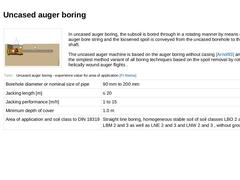
|

| (Image: Soil removal technique - uncased boring (free boring))
|
In uncased auger boring, the subsoil is bored through in a rotating manner by means of an auger bore string and the loosened spoil is conveyed from the uncased borehole to the starting shaft. The uncased auger machine is based on the auger boring without casing [Arnol93] and presents the simplest method variant of all boring techniques based on the spoil removal by rotating and helically … |
|
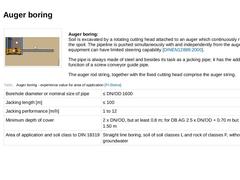
|

| (Image: Soil removal technique - auger boring)
|
Auger boring:
Soil is excavated by a rotating cutting head attached to an auger which continuously removes the spoil. The pipeline is pushed simultaneously with and independently from the auger. The equipment can have limited steering capability [DINEN12889:2000]. The pipe is always made of steel and besides its task as a jacking pipe; it has the additional function of a screw conveyor guide pipe. The … |
|
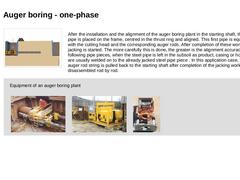
|

| (Image: One-stage jacking of steel pipe)
After the installation and the alignment of the auger boring plant in the starting shaft, the first pipe is placed on the frame, centred in the thrust ring and aligned. This first pipe is equipped with the cutting head and the corresponding auger rods. After completion of these works, the jacking is started. The more carefully this is done, the greater is the alignment accuracy. All the following pipe pieces, … |
|
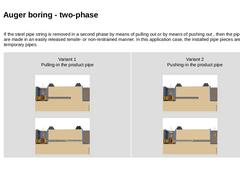
|

|
If the steel pipe string is removed in a second phase by means of pulling out or by means of pushing out , then the pipe piece are made in an easily released tensile- or non-restrained manner. In this application case, the installed pipe pieces are called temporary pipes. | Variant 1
Pulling-in the product pipe |
(Image: Auger boring - working sequence in two-phase jacking with reference to [FI-Lanci] [FI-Krupp] [Image: S&P GmbH] - Phase 1: Jacking the … |
|
|
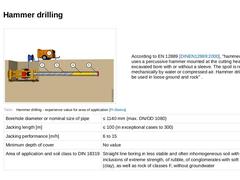
|

| (Image: Soil removal technique - hammer drilling)
|
According to EN 12889 [DINEN12889:2000], "hammer drilling uses a percussive hammer mounted at the cutting head in the excavated bore with or without a sleeve. The spoil is removed mechanically by water or compressed air. Hammer drilling may be used in loose ground and rock" . | (Table: Hammer drilling - experience value for area of application [FI-Steina]) |
|
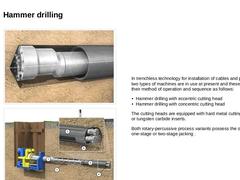
|

|
(Image: Down-the-hole hammer with eccentric cutting head and reamer and steel pipe with reference to [Arnol93] [Image: S&P GmbH] - Principle of operation)
|
|
(Image: SST method with reference to [FI-Asanu] [Image: S&P GmbH] - Overview sketch)
|
|
In trenchless technology for installation of cables and pipes, two types of machines are in use at present and these differ in their method of operation and sequence as follows: - Hammer drilling with eccentric …
|
|
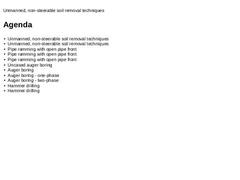
|

|
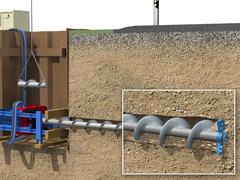
|

This lecture is part of the series "Trenchless 101" and serves to provide an overview of non-steerable trenchless new installation methods for gas, water and wastewater pipelines. |
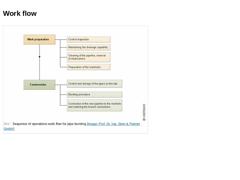
|
(Image: Sequence of operations work flow for pipe bursting) |
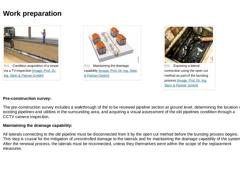
|
(Image: Condition acquisition of a sewer via a TV-inspection) (Image: Maintaining the drainage capability) (Image: Exposing a lateral connection using the open cut method as part of the bursting process) Pre-construction survey: The pre-construction survey includes a walkthrough of the to be renewed pipeline section at ground level, determining the location of existing pipelines and utilities in the surrounding area, and acquiring a visual assessment … |
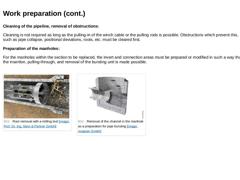
|
Cleaning of the pipeline, removal of obstructions: Cleaning is not required as long as the pulling-in of the winch cable or the pulling rods is possible. Obstructions which prevent this, such as pipe collapse, positional deviations, roots, etc. must be cleared first. Preparation of the manholes: For the manholes within the section to be replaced, the invert and connection areas must be prepared or modified in such a way that the insertion, pulling-through, … |
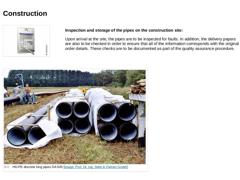
|
Inspection and storage of the pipes on the construction site: Upon arrival at the site, the pipes are to be inspected for faults. In addition, the delivery papers are also to be checked in order to ensure that all of the information corresponds with the original order details. These checks are to be documented as part of the quality assurance procedure. (Image: HD-PE discrete long pipes DA 500) |

|
(Image: Bursting head with a directional guide) Bursting procedure: Introduction of the new pipeline under the consideration of the permissible tensile forces and bending radii. There must be an overlap between the external diameter of the expander head and that of the new pipeline in order to reduce the frictional forces during the pulling through procedure. The tensile forces acting directly on the new pipeline during the bursting procedure must … |

|
(Image: Realisation of pipe bursting from the insertion manhole to the reception manhole) Manhole to manhole: Utilization of discrete pipes and bursting equipment suited to the size of the manhole structure. (Image: Realisation of pipe bursting from the insertion manhole to the reception pit) Manhole to pit: Utilization of discrete pipes and bursting equipment suited to the size of the manhole structure. Installation of the pulling equipment in the pit. |
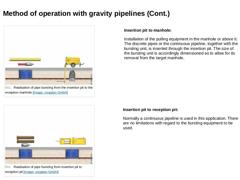
|
(Image: Realisation of pipe bursting from the insertion pit to the reception manhole) Insertion pit to manhole: Installation of the pulling equipment in the manhole or above it. The discrete pipes or the continuous pipeline, together with the bursting unit, is inserted through the insertion pit. The size of the bursting unit is accordingly dimensioned as to allow for its removal from the target manhole. (Image: Realisation of pipe bursting from insertion … |
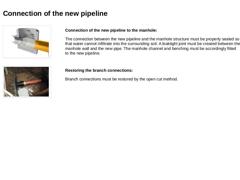
|
(Image: Connection of the new pipeline to the manhole) Connection of the new pipeline to the manhole: The connection between the new pipeline and the manhole structure must be properly sealed so that water cannot infiltrate into the surrounding soil. A leaktight joint must be created between the manhole wall and the new pipe. The manhole channel and benching must be accordingly fitted to the new pipeline. (Image: Re-connection of a lateral to the new … |
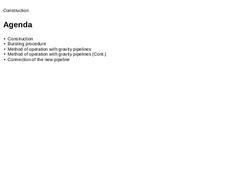
|
|

|
|
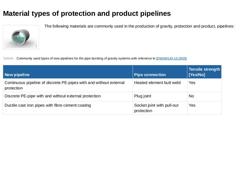
|
(Image: Gravity pipeline) The following materials are commonly used in the production of gravity, protection and product, pipelines: (Table: Commonly used types of new pipelines for the pipe bursting of gravity systems with reference to [DWAM143-15]) |

|
Other pipe types include: (Table: Other types of new pipelines qualified for the pipe bursting of gravity systems with reference to [DWAM143-15]) |
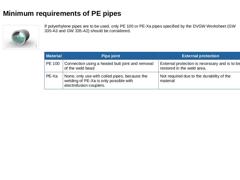
|
(Image: Gravity pipeline) If polyethylene pipes are to be used, only PE 100 or PE-Xa pipes specified by the DVGW Worksheet (GW 335-A3 and GW 335-A2) should be considered. |
Material |
Pipe joint |
External protection |
|
PE 100 |
Connection using a heated butt joint and removal of the weld bead |
External protection is necessary and is to be restored in the weld area. |
|
PE-Xa |
None, only use with coiled pipes, because the welding of PE-Xa is only possible with … |
|
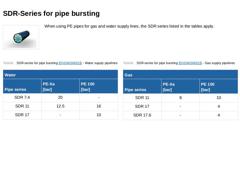
|
(Image: Rohricon) When using PE pipes for gas and water supply lines, the SDR series listed in the tables apply. (Table: SDR-series for pipe bursting - Water supply pipelines) (Table: SDR-series for pipe bursting - Gas supply pipelines) |
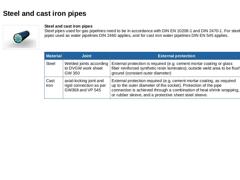
|
(Image: Rohricon) Steel and cast iron pipes
Steel pipes used for gas pipelines need to be in accordance with DIN EN 10208-1 and DIN 2470-1. For steel pipes used as water pipelines DIN 2460 applies, and for cast iron water pipelines DIN EN 545 applies. |
Material |
Joint |
External protection |
|
Steel |
Welded joints according to DVGW work sheet GW 350 |
External protection is required (e.g. cement mortar coating or glass fiber reinforced synthetic resin … |
|
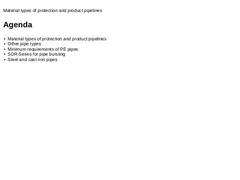
|
|
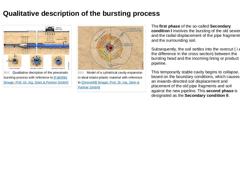
|
(Image: Qualitative decription of the pneumatic bursting process with reference to [Falk95b] [Image: S&P GmbH]) (Image: Model of a cylindrical cavity expansion in ideal elasto-plastic material with reference to [Zimme88] [Image: S&P GmbH]) The first phase of the so-called Secondary condition I involves the bursting of the old sewer and the radial displacement of the pipe fragments and the surrounding soil. Subsequently, the soil settles into the overcut ( … |